Now it's History (Ireland)! Peter Hart replies on Tom Barry and Kilmichael (but not Dunmanway)
 national |
history and heritage |
feature
national |
history and heritage |
feature  Friday April 01, 2005 10:47
Friday April 01, 2005 10:47 by Niall Meehan
by Niall Meehan
Hart Ignores Brian Murphy criticism, says Meda Ryan analysis not "rational"
(An introduction to this discussion can be found at this Indymedia article: What Is The Dispute About Kilmichael And Dunmanway Really About? The accusation that the IRA had a sectarian policy during the War of Independence will be addressed in a talk from historian Brian Murphy in Cork on April 15 at 8pm in the Imperial Hotel)
UPDATE: Audio (mp3) now available from: Radio Indymedia
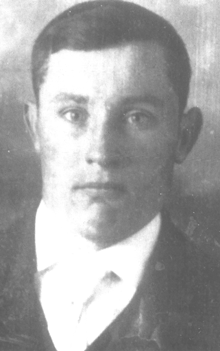
|
| Jim O'Sullivan - Killed after British Surrender |
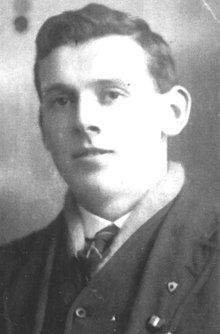
|
| Michael McCarthy - also Killed after British Surrender |
This is unfortunate, not least since Hart insists on a strong relationship between Kilmichael and Dunmanway: one is as important as the other to an understanding of the Cork IRA (1998:292). The killings in Dunmanway were the culmination of a long process of social definition that produced both the heroes of Kilmichael and the victims of the April massacre. (ibid)
(These and other references to Kilmichael and to Tom Barry that pepper Hart's account undermine his curious assertion that Kilmichael occupies only 6% of his book and his claim that Tom Barry appears as a minor character.)
The omission of a reference to Dunmanway is also surprising given that the interviewer wrote in The Village (Nov 6 2004) that the Dunmanway question is much more serious than the increasingly sterile debate about Kilmichael. Why then is Dunmanway ignored in the interview (except where Hart interjects a reference, of which more below)? It goes to the heart of Hart's contention that the violence of the war of Independence had an ethnic basis.
Whatever the reason, there is meat in the interview, but unfortunately not much. Hart asserts a) that he delivered a considered defense of his views on Kilmichael to postgraduate history students in Maynooth (The Truth about Kilmichael, 9 December 2004, followed by Christmas drinks), b) that the History Ireland interview is not the place to answer his critics in detail, and further c) that he will publish a detailed refutation.
In other words
a) Peter Hart has delivered a refutation (Maynooth);
b) he is not delivering it (History Ireland); but
c) he will deliver one (unspecified place and time in the future).
Knowledge of what was said in Maynooth is in short supply, since the audience was small and select. It would be of help (not least to neutrals in the debate) to publish the Maynooth talk here on Indymedia (I have written to Brian Hanley, who lectures in Maynooth, to see if that is possible). In the meantime, and in the absence of a more detailed response, we will make do with the morsels we have been provided with.
Hart's eyewitnesses
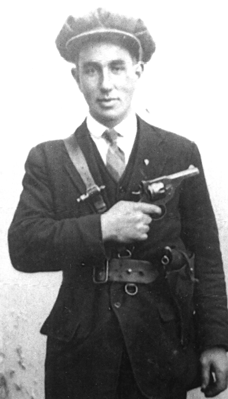
|
| Ned Young, last Kilmichael survivor, died Nov 13 1989 |
Peter Hart is circumspect about the sources of his anonymous eyewitness information that no false surrender took place at Kilmichael, confining himself to observing that most of the interviews were conducted by someone else. Three were conducted by the Rev Dr John Chisholm, who admitted in another context to using a free hand in composing recollections of IRA veterans, to visiting a location in order to imagine and then write up an IRA training camp, and to allowing the prevalence of my own style, when editing the memoirs of Liam Deasy (in Ryan 2003: 44, 274-5, 315).
Is Hart's an implied admission that the information may not be wholly reliable? Is he distancing himself from it? Even if so, the Chisholm interviewees do not say there was no false surrender; they do not mention the point.
Hart does not address at all the problem that his two anonymous interviewees spoke at a time when records indicate that only one infirm ambush survivor, Ned Young, was still alive (though not at that stage in full control of his faculties). Young died on 13 November 1989. Hart reported that he conducted his final interview, with scout 'AF', on 19 November 1989. I wrote previously (see web link in summary above): "This is an anomaly that needs to be addressed and for which there may be a simple explanation. As of yet, it has not been proffered."
Meda Ryan's (author of Tom Barry IRA Freedom Fighter) dating of the death of ambush survivors is supported by other accounts. In the absence of revelation of who Hart's interviewees were, he should be asked if he has unearthed previously unknown participants in the ambush. (There is anecdotal evidence that, as with the GPO in 1916, claims of participation swelled after the event.)
It is Hart's anonymous interviewees who allege that the story of the false surrender is itself false. It would be of value if Peter Hart could clarify the following in relation to the interviews:
1. Were notes used or was/is there a tape recording?
2. Who was present at the interviews?
3. Why was confidentiality insisted on? (i.e. the interviewee's reasons).
4. Why is confidentiality necessary now, as the interviewees are deceased?
Naming names
The absence of detail in Hart's account, his unwillingness to name his sources, as compared to Meda Ryan who names hers, leaves us with little option but to conclude that Ryan's is the more accurate account: that there was indeed a false surrender that participants spoke of openly.
An academic peer review might be the best way this matter could be concluded. Peter Hart might be asked if he would submit to one. Alternatively, if there are tape recordings, as Peter Hart suggests in his book, then perhaps Meda Ryan and Brian Murphy might be allowed to listen to the tapes under a guarantee of confidentiality. After all Peter Hart says he "respects" Murphy and Ryan's contributions to history.
Ryan not "rational"
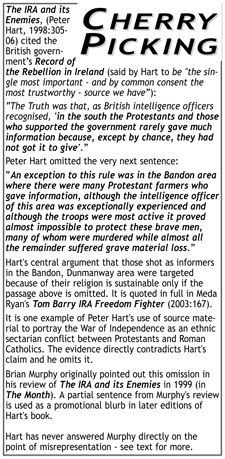
|
| Cherry Picking: The Passage that Hart Left Out |
When asked specifically about the criticisms of Meda Ryan and Brian Murphy, Hart asserts that as Murphy's work on British propaganda is not yet published he cannot answer Murphy's criticism. But Murphy's charge that Hart misrepresented the British admission that loyalists in the Bandon area did indeed engage in active informing during the war has been in the public domain since 1999 (see Cherry Picking for more detail). It is contained in a review of Hart's book in The Month, a partial sentence from which is reprinted as a promotional blurb when The IRA and its Enemies was re-printed.
In his talk on British propaganda on 15 October last in Dublin Murphy drew attention to Hart's editorship of The Record of the Rebellion, with the title British Intelligence in Ireland 1920-21, the Final Reports (Cork University Press 2002). Hart quoted the Bandon passage in full (see "Cherry Picking) on page 49.
However, this is accompanied by footnote 28. In the footnote Hart refers to the fact that he mentioned this passage in The IRA and its Enemies, giving pages 293-315, but no exact reference. Then, instead of apologising or even explaining why he made the significant omission, he justifies his use of the text! He writes several lines among which are found: "Some condemned West Cork Protestants did give, or try to give, information but there is no evidence that they acted en masse despite this statement." Hart then quotes the notorious Major AE Percival of the Essex Regiment to indicate that a few gave information. The reviewer of Hart's edition of the Record in The Irish Times, Brendan O'Cathair, described this footnote as "disingenuous". Brian Murphy noted in his talk that "the issue casts a serious reflection on Hart's use of sources".
Hart's response to Meda Ryan is surprising. He asserts that her book contains almost no new evidence. Not content with that put down, he also asserts that the critical analysis of his work by a woman historian is not "rational. Peter Hart is the first to spot this alleged failing on Meda Ryan's part, and he will probably also be the last. He should withdraw this comment in relation to someone whose contribution to history he respects. (Peter Hart has accused his critics of criticizing him in an "objectionable way" - see Indymedia link above)
Reviewers of Ryan's Tom Barry IRA Freedom Fighter (2003) have remarked on the wealth of evidence that Ryan has unearthed. She removed the lynchpin of Hart's case, that Tom Barry did not mention the false surrender until the publication of his Guerilla Days in Ireland in 1949, that he invented it many years after the battle. The apparent failure to mention it in a major 1932 article by Barry on Kilmichael for the Irish Press was promoted by Hart as a most significant item of evidence. However, Ryan quoted a contemporaneous letter from Barry to the Irish Press criticizing the paper for editing out the reference.
False surrender noted in 1921
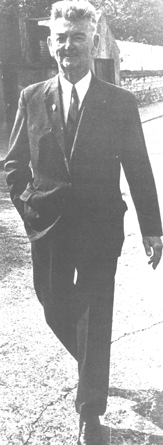
|
| Tom Barry in 1949. The year his Guerrilla Days in Ireland was published |
As Ryan showed, reference to the false surrender first appeared in print in 1921 from a British source, Lloyd George's imperial advisor Lionel Curtis, who wrote: It is alleged by Sinn Fein that a white flag was put up by the police, and that when the attacking party approached to accept the surrender, fire was opened on them. (in Ryan 2003: 56). While also referring to mutilated bodies (a piece of British atrocity propaganda) Curtis expressed himself unsure of the truth of this notorious episode. However, he said the surrender story was obtained from a trustworthy source in the district. (ibid) Piaras Beaslai's life of Michael Collins in 1926 contained: When volunteers advanced to take the surrender, they were fired on. (ibid) Hart asserted that General Crozier, commander of the Auxiliaries at that time (who resigned in protest at the failure to curb Auxiliary atrocities) referred to the false surrender in Ireland Forever, (1932), only because he wished to curry favor with republicans. Hart appears to have missed Barry's reference to the false surrender in a piece he wrote for the Irish defense forces magazine, An Cosantoir, in 1941. Of course, as Hart himself admits, the false surrender story was "circulating within the IRA as early as 1921", (1998:27 fn 21). So why would Barry be required to invent it in 1949?
Ryan's interviews with Kilmichael veterans all elicited references to the false surrender. Down through the years, the only person to cast doubt on the false surrender is Peter Hart, arriving on the scene in 1998. There has never been the slightest hint that any participant in the Ambush ever denied that it occurred apart of course from the anonymous admission promoted by Hart, which cannot be validated.
If the false surrender story was a gigantic lie, it was one concocted by over 36 members of the ambush party and three scouts that stood the test of time until Peter Hart came along. Hart's anonymous source, who regarded the story as an insult to the memory of those who fought at Kilmichael, contained his umbrage for well over 60 years, before deciding to get it off his chest and revealing it to a visiting Canadian academic.
It is surprising that during all that time no ambush participant, even in the anonymous and confidential accounts given to the Bureau of Military History in the 1950s (some years after the celebrated and world wide publishing sensation that was Tom Barry's Guerrilla Days in Ireland in 1949) blurted out that Barry's false surrender story was a tissue of lies. Peter Hart's witness for the prosecution did not avail himself of the opportunity. Instead he silently nursed his grievance concerning the supposed monumental insult to those who fought at Kilmichael for another 30 years. If Peter Hart had not come along, the anonymous source might have taken the story to his grave and we would now know nothing about it. In which case this opportunity to question the methods of revisionist historiography might also have been lost. In his interview Peter Hart refers to the revisionist debate as being incoherent. Readers are left to judge for themselves where the incoherence lies.
Psycho Killer
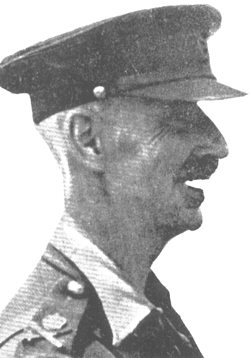
|
| The notorious Major AE Percival. His Essex Regiment tortured & executed prisoners. He surrendered Singapore to a force of Japanese on bicycles in 1942 |
In the interview Hart implies that his reference to Barry as a serial killer was journalistic inference. In fact it was a direct quotation from Hart, given to the Sunday Times (April 19, 1998): "Barry is still considered to be an idealistic figure, unlike the great majority of his comrades he was little more than a serial killer and thought of the revolution largely in terms of shooting people. His politics were very primitive."
Hart's outburst is one that Ryan demonstrates to be false, as is Hart's claim that Barry had a record of killing prisoners. There is clear evidence that Barry released combatants after battle, based on whether the particular British regiments they were from did or did not torture and/or execute IRA prisoners. For example, after the Rosscarbery ambush Barry permitted medical treatment for prisoners in the local convent. (Ryan 2003:111) A policy decision was taken to execute members of the notorious Essex Regiment, which exacted brutal treatment on IRA prisoners (commanded by Major AE Percival, who was to gain world renown in 1942 when he surrendered the British garrison in Singapore to a force of Japanese on bicycles).In the interview Hart refers to serial killers on both sides who were not necessarily psychopaths. They were individuals and small groups who did the dirty work. Thus the Dublin squad', commanded by Michael Collins, which wiped out the British intelligence apparatus on Bloody Sunday in November 1920 (one week before the Kilmichael ambush), were hard men who did this dirty work. Barry is consigned to membership of this group of not necessarily but maybe psychopaths.
However, Hart's forthcoming biographical subject, Collins himself, was a sort of hail fellow well met' who "would be a great guy to have a beer with or be friends with". The difference between Collins and Barry would appear to be that the former gave orders to others to do the shooting, while the latter was a commander in the field (and perhaps not such a gregarious drinking companion). Frankly, I find these distinctions facile.
Hart says I respect people who took the moral aspect of the choices they took seriously who refused to become assassins or to engage in ambushes. One wonders how the IRA could have defeated the British Empire had it been staffed by soldiers who refused on moral grounds to be part of an ambush party. After this comment Hart goes on to discuss the Kilmichael ambush.
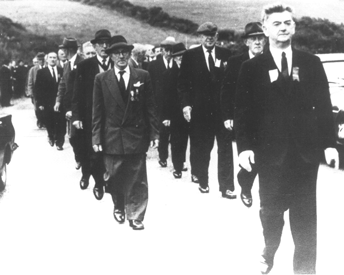
|
| Tom Barry leads Kilmichael Ambush survivors in 1966 |
In his soliloquy on the distinction between certain types of republicans, Hart said I do think highly of those republicans who tried to put their ideals above tactics, who tried to avoid or refused to be drawn into sectarian violence that they found morally wrong: people like Tomas MacCurtain, Terence MacSwiney, and then Sean Moylan and Liam Lynch who tried to stop the Civil War. It is either a faulty memory or perhaps some other factor that caused Hart to fail to mention Tom Barry in that regard. Brian Hanley might have reminded Peter Hart of Barry's role in attempting to stave off Civil War, as his book, The IRA 1926-36, refers to it (2002:143). Reference to Tom Barry the peacemaker conflicts with the tabloid depiction of Tom Barry the "serial killer" or "hard man". Similarly the evidence that Tom Barry let British prisoners go does not gel with the story of the prisoner killer. Presumably that is why it is ignored. Taken with Brian Murphy's revelation on the use of archive material, perhaps we should not be surprised.
Hart misrepresents criticism of documents he claims are genuine, but which his critics say are British forgeries. He asserts that his critics "can't deal with the contents". Presumably he has Meda Ryan and Brian Murphy in mind. In his book Hart makes great play of an alleged captured battle report from Barry that gets basic facts wrong, not least about the time and circumstances of the ambush or how casualties occurred, and which does not mention the false surrender. Hart asserted that there is no case of the British ever having forged an IRA document. He will be surprised to note that Brian Murphy has come across many such instances. Hart insists that the document is genuine, despite its many shortcomings as to matters of fact that would ordinarily come as second nature to Barry. Hart is forced into convoluted argument as to why Barry would lie about basic facts that have no bearing on his immediate or historical legacy.
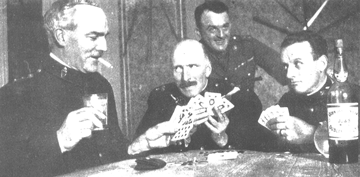
|
| RIC & Auxiliaries take time off from "hunting assassins" (from captured British officer's papers) |
Murphy and Ryan accuse Hart of being selective in accepting some parts of a document as accurate and, for no logical reason other than that it does not suit his argument, rejecting another part. The use of the Record is a classic example.
Hart dismisses criticism of his analysis of the Dumanway shootings. He then immediately accused his critics of not wishing to subject "Tom Barry or anybody else who takes it upon himself to kill other people" to any form of scrutiny. Aside from the asinine nature of this observation, the physical juxtaposition of the Dunmanway killings with the name of Tom Barry is unfortunate. Hart must surely be aware from reading Meda Ryan's book, if not from his own less than exhaustive researches, that Tom Barry rushed from Dublin to stamp out the wave of killings.
A finding of irrationality in relation to Meda Ryan's analysis, and Peter Hart's assertion that there is almost no new evidence in her book must be considered perverse in the circumstances. Hart must know that Ryan has shown conclusively that those shot in Dunmanway were on a list of helpful citizens, left behind by K Company of the Auxiliaries when they left Dunmanway Workhouse. It is but one example of new evidence produced by Ryan. Her relating of the list to the existence of the paramilitary loyalist gangs that operated with British forces is also new. Does Peter Hart still sit in dogged dismissal of this evidence? His book dismissed official references to the loyalist gangs for no apparent reason other than, again, it did not suit his argument that Protestants who were shot by the IRA were shot because of their religion.
Is it possible that Peter Hart has not read Meda Ryan's book?Neighbour against Neighbour
Hart's account of Kilmichael reinforces his view that this was a war of neighbour against neighbour (as the flyleaf of Hart's book has it). I have already written that Hart's depiction of what happened at Kilmichael is the basis for his assertion that this was an ethnic and not an anti colonial or anti imperialist conflict.
Undermining the accepted account of the Kilmichael ambush (and battle of Crossbarry, where Hart alleges that only 10 British soldiers died, not the accepted figure of thirty five to forty) is essential for Hart's view to survive. Strict adherence to his a priori construct forces Hart to dismiss all evidence to the contrary. As noted above, official references to the paramilitary loyalist Anti-Sinn Fein league in Dunmanway and other areas of West Cork, working alongside the RIC and other British forces, are dismissed out of hand by Hart. To admit the existence of this unique, to the South, organisation of paramilitary loyalism would be to admit that, as was recognized even by British commentary, there was no sectarian element to the IRA's targeting of informers or other enemy agents.
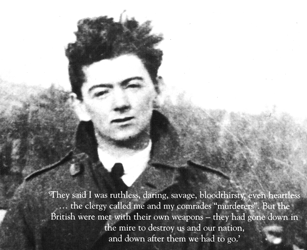
|
| Tom Barry in 1920: "The British had gone down into the mire to destroy us and our Nation and down after them we had to go" |
Ryan quotes Lionel Curtis writing early in 1921 on when a brave prelate spoke out in Cork, his flock turned their back on him and evoked the rejoinder we take our religion not out politics from Rome. Therefore, to conceive the struggle as religious in character is in any case misleading,,,, Protestants in the south do not complain of persecution on sectarian grounds. If Protestant farmers are murdered, it is not by reason of their religion, but rather because they are under suspicion as Loyalist. The distinction is fine, but a real one. (2003:170)
There is little sense in Hart's book that the rhetoric of opposition to, or of adherence to, the British imperial system animated those fighting in what Manus O'Riordan has called the 20th Century's first war for democracy. Even though Tom Barry and other republican leaders saw their role as defeating the colonial system and the British Empire, and that the British and their allies (including unionists) saw their role as defense of that system, Hart is blind to his animating factor. The British saw Irish independence as a potential domino that could topple the Empire. And they were right, since leaders of anti colonial movements in Asia and Africa took great encouragement from the Irish example. This is unremarkable in a certain sense but needs to be emphasized because Peter Hart has no conception of its importance or relevance. It leads him to ignore the efforts of British propaganda to impose a sectarian ethnic character on the War of Independence.
It is classic colonial policy to portray the enemies of imperialism as sectional or tribal' interests opposing the evenhanded efforts of progressive colonial administrators to steer an even course in the midst of great difficulties, etc. In a sense Peter Hart's is a replay of British propaganda of the period. For example he emphasizes the Protestant religion of casualties of IRA violence and downplays or ignores the fact that religion was immaterial to Tom Barry, who was always careful to draw a distinction between 'loyalist' and 'Protestant'. Barry noted that "bigotry was not confined to the Protestants for the ignorant and petty-minded Catholics had their fair share of this ancient curse". (in Ryan 2003:170) Hart's big failure is the inability to note that many Protestants supported the War of Independence. But then to see that would negate the central plank of his argument. More Roman Catholics than Protestants were found to have been and were exposed or shot as informers in West Cork.
Left-wing veneer
Another aspect of Peter Hart's work is the adoption of a sort of sociological history, which gives his analysis a left-wing veneer, evidenced by apparent concern for tramps and vagabonds being the object of IRA attentions. Similarly a hierarchy of rank within the IRA is remarked upon in one of the many asides that clutter Peter Hart's account. Thus the scouts that played an important role during the Kilmichael and other ambushes are small fry that are generally written out of history. As Meda Ryan has pointed out (in one of her many lucid findings) this observation bears no relationship whatever to the military situation at the time, to the important and highly exposed role played by scouts, or to the formal recognition afforded to them by Tom Barry and others. What does stand out from Hart's account is a consistently negative attitude to Tom Barry and attempts to undermine his historical standing, despite evidence to the contrary.
Negative view of unionism
What is new in Peter Hart's interview is a more negative view of unionism and its role. Thus, though "there was no ethnic cleansing in the Irish revolution (although the attacks on Catholics in Belfast came close)
unionists had direct links to death squads, and people like Edward Carson encouraged the riots in the shipyards. Incidentally, I think that one of the big untold stories of this period is how Protestant churches behaved In the North - it's not a pretty picture." If nothing else, that comment, if given wide enough currency, may put an end to the promotion of Peter Hart's views by unionist and Orange web sites.
Nationalist rhetoric is recognized as having an anti-sectarian character and intent: "One key difference between North and south was that in the South it was not the Free State or the Catholic church that was responsible for anti-Protestant violence - they were largely blame free."
If that is the case, why does Peter Hart insist that the killings in Dunmanway were carried out on the basis simply of targeting Protestants? If true a blatantly sectarian act and one that Hart says was in keeping with the sectarian and ethnically based war carried out on the republican side (which included those who were to lead the Free State). Of course Meda Ryan has demonstrably set out the circumstances under which, in defiance of an IRA amnesty, these post truce killings of informers and enemy agents took place and their non-sectarian character. She shows the united opposition to the killings from both pro and anti-Treaty sides during this pre-Civil War period.
It may be that Peter Hart has begun to subjectively respond to and to unconsciously accept the criticism of Murphy, Ryan, Lane, Clifford, O'Riordan and others. It may be that some of the criticism is refracted through the academic community. If so it begins to render his overall thesis in relation to ethnic and sectarian conflict in Ireland, to use his own terminology, incoherent. Hart says that to impose "categorical differences" between republicanism and unionism is a "partitionist fallacy". However, the only way in which a sectarian form of government could be preserved in Ireland was to allow the creation of sectarian state in Northern Ireland, separate from the non-sectarian character of Irish nationalism, connected to but also separated off from the politics of the British state. In effect a colonial enclave having the trappings but not the substance of democracy.
Peter Hart offers us sectarianism on an all-Ireland basis. His anti partitionism is a justification of Partition on the basis of sectarian irreconcilability.
It is an unfortunate legacy of the 26 County State that the emergence of a vibrant and secular civil society has created an intelligentsia that confuses the ideological history of the state with those who fought to bring it into existence. Almost from the day that Michel Collins was shot the southern state mapped out a policy of conservative ideological control based on the Roman Catholic Church and preservation of the border, combined with a political rhetoric calling for its end. The attraction of Peter Hart's analysis is that it projects this political outlook backwards into the War of Independence period. However, it reads history backwards. This may be a reason why some find Hart's analysis congenial
Examination of the ideas and actions of those who fought the War of Independence reveals that this is not what they had in mind. Britain imposed the Oath of Allegiance and Partition, as it was determined to partly salvage through aggressive diplomacy what could not be achieved in war. For a comparatively short historical period it appeared as though there were two sectarian states appearance, not reality, there was in truth only one.
Irish nationalists were controlled ideologically in the South, through control by the Roman Catholic Church of many aspects of civil society, and coercively in the North through systems of discrimination and abuse of state power. Since the 1960's they have broken out of the Catholic and Irish' role ordained for them by the settlement imposed by the Treaty of 1921. An assertion of Irishness being equal to Roman Catholicism would be regarded as political lunacy. The association of Protestant and Unionist is still the preserve of unionist political orthodoxy. Unfortunately, there are those who occasionally attempt to project a unionist consciousness on to southern Protestants as a whole and who promote the Orange Order as part of Protestant 'culture'. Protestants in the south usually give them short shrift.
The reason anti-sectarian ideas have such a hold on republican and Irish nationalist consciousness in general is because of the efforts and outlook of Tom Barry, Sam Maguire (a Protestant republican from Dunmanway after whom the GAA all Ireland football trophy is named) and others before and after them.
To get back to Peter Hart, maybe he has moved on from his 1998 work, but he has not answered the criticism. That, by his own admission, we still await. What we have in the History Ireland interview is a combination of defensive assertions and contradictory comments, combined with a sexist characterization of the work of Meda Ryan.
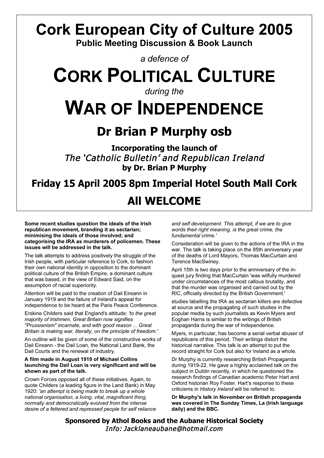
Meeting on nationalist culture in city of culture in Imperial Hotel April 15